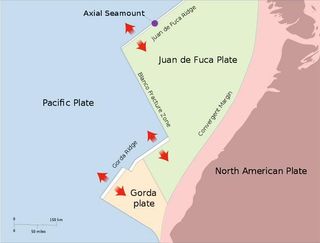
Magma Proves Undersea Volcanoes Do Explode
Deep-sea volcanoes can explode instead of just oozing, scientists now confirm.
The new proof higher-than-expected levels of carbon dioxide in the magma from a volcano off the coast of Oregon suggests the volcanoes may play a greater role in global climate than thought.
Of all the volcanic activity on Earth, 75 to 80 percent of it takes place at deep-sea ridges in the middle of the oceans. Most of these volcanoes apparently spew out huge volumes of lava instead of erupting explosively , as many volcanoes on land do.
It is a high level of gas trapped in a volcano's magma that normally fuels explosive volcanic bursts. This level has long been thought to be low at mid-ocean ridges; moreover, potential undersea explosions would be suppressed by the crushing pressure from the surrounding water.
However, based on volcanic ash found at certain sites, geologists have speculated over the last decade that explosive eruptions do take place in deep-sea volcanoes . Now researchers say they have proof.

A team of scientists used ion beams to analyze the composition of materials recovered from ash deposits on Axial Volcano, on the Juan de Fuca Ridge off the coast of Oregon. Trapped within crystals from the deposits were droplets of magma containing very high levels of carbon dioxide. These droplets revealed that the magma was indeed rich in gas, at concentrations high enough to generate bubbles in the molten rock for explosive underwater eruptions.
"Direct evidence for high carbon dioxide concentrations in a mid-ocean-ridge volcano was unexpected and surprising," researcher Christoph Helo, a volcanologist at McGill University in Montreal, told OurAmazingPlanet.
Sign up for the Live Science daily newsletter now
Get the world’s most fascinating discoveries delivered straight to your inbox.
These findings suggest the amount of the global-warming gas carbon dioxide that is released from the deeper mantle into the Earth's atmosphere at mid-ocean ridges falls within the higher end of past estimates, nearly 10 times more than the lowest end. That could have key implications for climate change.
Still, Helo said, volcanic carbon dioxide, unlike man-made emissions, "is not a variable that has undergone drastic changes within the past century."
The scientists detailed their findings online March 13 in the journal Nature Geoscience.












